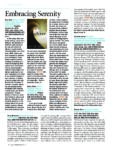This study by Jane Brox examines the role and effects of silence in penitentiaries and monasteries over many years. While silence was once imposed on prisoners as a punishment, it was freely accepted by those entering monasteries as a means of deepening their spiritual lives. Nineteenth-century prison founders believed that isolation and silence would lead to convicts’ redemption but failed to see potential dangers in such practices, including a loss of contact with reality and risk of insanity. In contrast, monastic silence was not absolute but intermingled with chanting, reading aloud, and limited conversation. Silence and isolation are now gone from most American prisons, and many monasteries closed, their silent lives vanishing in an increasingly noisy world. Brox’s balanced account shows both the positive and negative aspects of silence and points out the need to be attuned to our inner voice in a world of constant distractions.
Home › Power of Silence › Silence: A Social History of One of the Least Understood Elements of our Lives
-
Recent Posts
Recent Comments
Archives
Categories
- #MeToo
- Bad Leadership 2021
- Building a Personal Brand
- Creating an Elevator Pitch
- Crisis Leadership 2020
- Crisis Management 2021
- Dealing With Bad Leaders
- Derailment
- Effective and Evolving Communication
- Embracing Corporate Culture: How to Thrive in the Workplace
- EQ Emotional Intelligence
- High-Performing Hybrid Teams 2022
- How to Build a High Performance Team – 2020
- Imposter Syndrome
- Leadership in Crisis
- Leadership in Transition
- Leading Change – When it is Unexpected
- Leading Divergent Perspectives
- Leading in a Matrix Organization
- Mindfulness
- Mission Tactics (Commander's Intent)
- Motivating and Inspiring
- Networking and Influence
- Outsider Leadership
- Passages
- Power of Silence
- Power of Transparency
- Powerful Presentations
- Professional Networking
- Radical Candor/Crucial Conversations
- Reflection/Pause
- Reframing in Leadership
- Story Telling
- Unconscious Bias
- Why Does Perspective Matter in Leadership?
- Work-Life Balance
Meta
